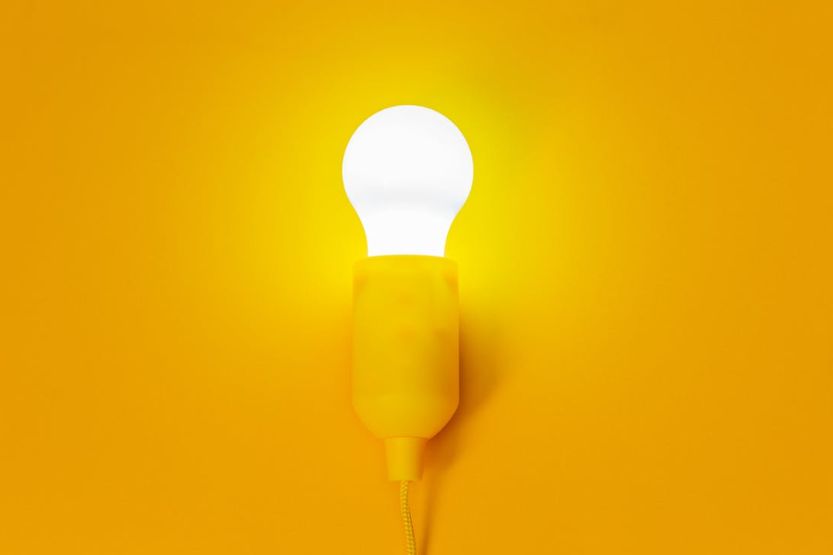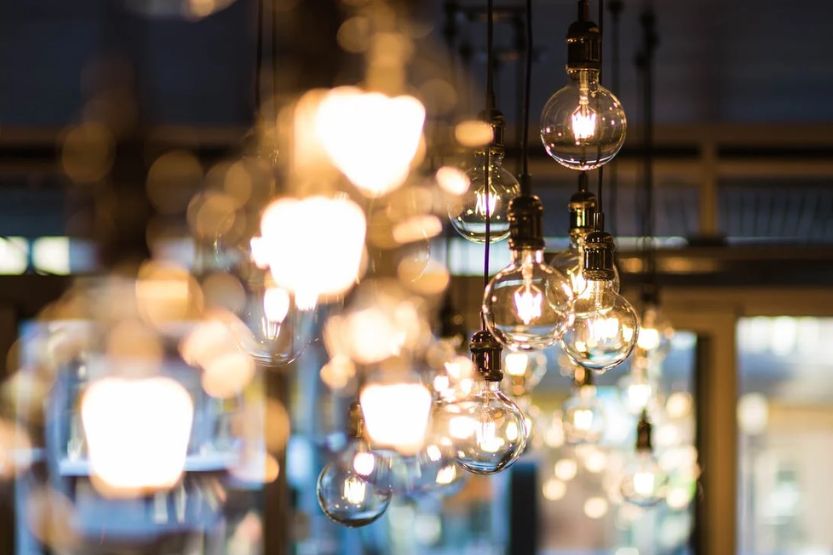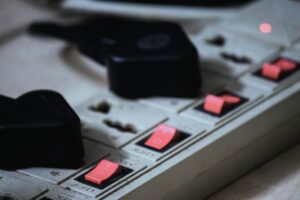If you talk to a lighting expert, they’ll tell you that lumens are an essential measure of light bulb brightness. But what are lumens? And how bright are they? This guide will help you understand how lumens work and how you can use them to find the right bulb for your needs.
A lumen is a unit of measurement for visible light emitted by a source. In most cases, the more lumens there are, the brighter something will be.
The chart below shows the comparison of lumens to watts for CFL, LED, incandescent, and halogen lamps:
| Brightness in LUMENS | More than 220 Lumens | More than 400 Lumens | More than 700 Lumens | More than 900 Lumens | More than 1300 Lumens |
| CFL | 6W | 9W | 12W | 15W | 20W |
| LED | 4W | 6W | 10W | 13W | 18W |
| Incandescent | 25W | 40W | 60W | 75W | 100W |
| Halogen | 18W | 28W | 42W | 53W | 70W |
Read on to learn more about lumens, how many lumens you need, and the brightness level you can expect from each.
What Is a Lumen?

Equal to Light Output
Consider lumens the “new” method of knowing the brightness of a lamp. Remember that lumens are equal to light outputs.
Unit of Measurement
Lumens, represented by the symbol “lm,” are a measurement of the total amount of light emitted by a lamp or other light source and are visible to the human eye. The lamp will appear “brighter” if its lumen rating is higher.
You may have purchased standard bulbs or spotlights rated at 50 to 60 watts with the expectation of a certain brightness level. However, this erroneously linked the amount of power consumed (in watts) to the amount of light produced.
Low-energy LED Bulbs Produce More Lumens Per Watt
Low-energy LED bulbs have more light output while consuming significantly less energy. One example would be a 6.5-watt LED lamp that produces a similar amount of light to that of a 50-watt halogen bulb. That’s an energy savings of 87% for the same light output.
When LEDs are used, there is a greater energy conversion into light than heat. More lumens per watt will be produced as technology advances, resulting in more brightness and reduced power consumption. In other words, using watts as a guide to brightness is no longer applicable.
How Many Lumens Do You Need?
The amount of light you need usually depends on what you’re using it for:
1. Portable Work Lights
If you’re looking for a work light, you’ll want something that provides enough brightness to see what you’re doing without being too bright.
The optimal lumen output for portable work lights is between 250 and 600, with 500 as the sweet spot. Some portable work lights are adjustable, making them ideal for various situations. And when using standing work lights, having 3000 to 10000 lumens provides the most versatility.
2. Reading
If you’re looking for a reading lamp, you’ll want something that provides enough brightness to see the pages. 450 lumens or 40 watts is enough for most reading and writing activities.
For reading lights, also consider whether or not the light is adjustable. Adjustable lights allow you to change the direction and angle of the beam so that it hits your eyes at an angle that will allow you to read comfortably.
3. Delicate Tasks
When working with small pieces or delicate tasks like heavy-duty drafting, you need around 800-1100 lumens or 60-75 watts.
What Is Better 4000K or 5000K Lighting?
How Bright Are Different Lumens?
Let’s look at how bright different lumens are:
1. 4000 Lumens
Having 4000 lumens means that the lamp emits the intensity of 4000 lumens of light. Brightness measurement is done in lumens, and one lumen is equal to the brightness of one candle. So the brightness of 4000 lumens is equivalent to that of 4000 candles.
Uses
- Suitable for compact fluorescent lamps (CFL), LED, and incandescent lights.
- Good for downlighting, recessed lighting, uplighting, and suspender or pendants, among other lighting applications.
- Enough for most outdoor uses. It has a brightness level suitable as a security light because it can light up a large area.
Too Bright for Reading
A light of about 4000 lumens directly on a page would be too bright for reading. However, it also depends on the distance between the book and the light source.
If the light comes from the ceiling, then this brightness level is acceptable as long as there’s no page shadowing from other adjacent materials.
Products with 4000 Lumens
- LED bulb
- Security light
- Flashlight
- Camping lantern
- Projector
- Car headlight
2. 3000 Lumens
Having 3000 lumens means that the lamp emits the intensity of 3000 lumens of light. Brightness measurement is done in lumens, and one lumen is equal to the brightness of one candle. So the brightness of 3000 lumens is equivalent to that of 3000 candles.
Uses
- Suitable for compact fluorescent light, LED, and incandescent lights.
- Enough for most outdoor uses as it can light up a large area.
- Ideal for lighting up buildings while enhancing security and landscaping.
- Excessively bright for indoor settings in residential homes. But it might work for spaces with higher ceilings.
- The flashlight’s brightness of 3000 lumens is quite suitable for its class. It will produce a beam of light that covers a large area since the flashlight’s design is focused and directed forward. When the beam of a flashlight is broader, the light produced will be less intense and, as a result, appear dimmer. However, the light emitted becomes more concentrated when the beam is narrower.
- When riding at night, having a bike headlight with 3000 lumens will provide you with a clear view of your surroundings. Because it is also effective at being seen by other vehicles, it is an excellent choice for a safety light.
- The brightness of a projector with 3000 lumens is suitable for most home theaters and commercial settings. It can display a large image on a wall or screen in a dark room.
Products with 3000 Lumens
- LED bulb
- Security light
- Flashlight
- Bike headlight
- Light bar
- Projector
3. 2000 Lumens
A LED light with a lumen rating of 2000 is an extremely bright light source that may be unsuitable for some applications. It’s not ideal for general room lighting, requiring more subtle illumination.
Under these conditions, consider purchasing an LED light bulb with a lower lumen output, such as 1000 lumens. This will still supply more than enough illumination for most activities.
Uses
- The light output of 2000 lumens is suitable for compact fluorescent light, LED, and incandescent lights. You can use it for commercial downlighting, recessed lighting, uplighting, floodlighting, and outdoor security applications.
- Ideal for outdoor activities that require a more powerful flashlight.
- Good light output for the main ceiling light in an average-sized room. Working on a computer, reading, or watching television will all be comfortably bright.
Not Recommended for Bike Lights Unless Riding in Unlit Roads
A bike light with a 2000-lumen output is way too bright for most settings unless you’re riding on dark roads or trails with no lighting at night.
Also, it’s important to note that although 2000 lumens might seem like a lot of light, some of the output will be lost in the light fixture. For this reason, you might need to compensate with a greater output or look for a fixture that can accommodate multiple bulbs.
Products with 2000 Lumens
- Head torch
- Security light
- Camping Lantern
- LED bulb or strip
- LED downlight
4. 1000 Lumens

Uses
A good starting point for the main ceiling light in an average-sized room. It will give enough brightness for general tasks such as watching TV, working on a computer, or reading.
Reading requires light that’s not too harsh, which 1000 lumens provide. It will provide sufficient illumination to view the page without glare or extra UV rays, which can harm your eyes over time.
Most current LED solar lights are not as bright as a solar light with 1000 lumens.
However, even though 1000 lumens can seem like a lot of light, some of the output will be lost in the light fixture. So you might need to compensate with a higher output or look for a light fixture with several bulbs.
And if the brightness level is increased, remember that rechargeable batteries need to be of sufficient size to provide the necessary power for a good amount of time. Always check the expected run time for a fully charged battery.
Products with 1000 Lumens
- Camping lantern
- Head torch
- Security light
- LED bulb, strip, and downlight
Again, how bright are different lumens? Lumens measure the amount of light from a bulb. The higher the bulb’s lumen, the brighter light is. Take note of this when you buy lamps or bulbs.
5. 900 Lumens
Uses
- More than enough for use in living areas.
- Suitable for certain commercial areas and outdoor spaces where you want to be visible from a considerable distance.
- If you have a flashlight with 900 lumens or more, there’s a good chance that you’ll be able to see a distance of at least 100 meters.
Is 900 Lumens Bright?
900 lumens in average-sized rooms won’t feel excessively bright. So if you want a brighter light, consider using an extra lamp or bulb that would give out the same amount of brightness as 900 lumens.
When using an LED as a light source, 900 lumens is typically equivalent to 9-12 watts. And it’s around 60-100 watts when using incandescent light sources.
Products with 900 Lumens
- Security light
- Headlamp
- Solar spotlight
- LED bulb, strip, and downlight
6. 800 Lumens
The brightness of an 800-lumen light is comparable to that of a single incandescent light bulb rated at 60 watts. This light is more suitable for a walk-in closet and not the whole room.
Is 800 Lumens Bright?
A room or space with an 800 lumens light bulb will be somewhat dimly lit. When using an LED as a light source, 800 lumens is typically equivalent to 12 watts. It’s around 60 watts when using incandescent light sources.
Lighting Products with 800 Lumens
- Camping lantern
- Head torch
- Security light
- LED bulb, strip, and downlight
7. 700 Lumens
It takes 700-1300 lumens to power flood lights, while motion sensor flood lights require lumens ranging from 300 to 700. Since these lights have ranges, the brightness may also vary.
Is 700 Lumens Bright?
700 lumens is bright, but it’s not as bright as you think. A 100-watt incandescent bulb emits about 1,600 lumens, and a 60-watt bulb emits approximately 800 lumens.
So 700 lumens is dim compared to those numbers, but it’s still bright enough to illuminate a large area and make it easier to see what you’re doing.
8. 600 Lumens
600 lumens is not bright enough for an average-sized room, so you must install it at different heights and with various lighting products.
Is 600 Lumens Bright?
600 lumens LED downlight is bright enough for most homes. It is an average recessed light output that provides an excellent light beam. This light output is suitable for ceiling heights up to 9 feet.
9. 500 Lumens
The light output of 500 lumens is suitable for compact fluorescent light, LED, and incandescent lights. You can use it for downlighting, recessed lighting, uplighting, and suspender or pendants.
Is 500 Lumens Bright?
Up to 500 lumens won’t be bright enough for an average-sized room. To achieve the desired illumination level in a living room, you will need to consider using more than one bulb or lamp with a lumen output of between 1000 and 2000.
If you want a level of ambient lighting without the primary light source, then anything up to 500 lumens will suffice.
10. 400 Lumens
The brightness level of a regular 40-watt (40W) bulb is equivalent to more than 400 lumens. Most GU10 LED lights to have a standard output equivalent to 400 lumens. You can use this bright light for various lighting applications throughout the house.
Is 400 Lumens Bright?
The amount of light typically present in a bedroom is approximately 200 lumens. However, this will depend on the space’s size, the ceiling’s height, and the brightness level you prefer in your surroundings.
If you want a level of ambient lighting without the primary light source, then anything up to 400 lumens will suffice.
11. 300 Lumens
300 lumens is a relatively low light for CFLs, LEDs, and incandescent bulbs.
Is 300 Lumens Bright?
Accent lighting and reading can both benefit from its illumination. Its lumen output is comparable to that of lower-quality GU10 LED lights. For practical applications, you may find that increasing the lumen output between 400 and 500 produces better results.
12. 250 Lumens
Generally, 250 lumens is a low level of CFL, LED, or incandescent lighting. You can use it to highlight items on shelves or alcoves. It can also provide close-up task lighting on kitchen countertops and activities such as reading.
Is 250 Lumens Bright?
25-watt incandescent lights have equivalent brightness of 250 lumens. It is not advisable to have this brightness level in spaces designated for sitting, such as restrooms and kitchens. On the other hand, an LED light with 250 lumens is suitable for usage in a corridor or any outdoor area.
13. 200 Lumens
Landscape lighting with a brightness of 200 lumens is sufficient to make an outdoor area comfortable for sitting. You can also use this brightness level around your yard’s pathway, pond, or pool. Most standard household flashlights have 200 lumens as well.
Is 200 Lumens Bright?
Regarding CFL, LED, and incandescent lighting, 200 lumens is considered a low light level. It is enough for reading and providing decorative accent lighting.
However, it is not very useful for anything else. To make it effective in most situations, you will need to increase the lumen output to at least 500.
14. 100 Lumens
An average flashlight has 100 lumens, and you can use it to scan small yards in both urban and suburban settings. It provides a good brightness level for medium-sized flashlights.
Is 100 Lumens Bright?
Most walkways, including those on commercial properties, are bright enough with 100 lumens. 100 lumens is comparable to 20 watts of light output.
15. 50 Lumens
50 lumens isn’t very bright. It’s more of a “be seen” light than a “seeing light.” So if you want something bright enough, go with at least 800 lumens, ideally something closer to 1500. However, 50 lumens is enough for accent lighting in gardens.
Is 50 Lumens Bright?
50 lumens is bright but not bright enough when used in a dark room. You ideally need between 500 and 2000 lumens if you want effective bright lights.
What Does a Red Porch Light Represent?
Frequently Asked Questions – Brightness of Different Lumens

How Many Lumens Is Considered Bright?
In general, 100 lumens provide enough lighting for sidewalks or walkways, even those in commercial areas. It’s roughly comparable to 20W.
Is 4000 Lumens Bright?
Yes, it’s bright. You can use 4000 lumens as a security light as it effortlessly illuminates areas around your properties.
Is 3000 Lumens Bright?
Yes, it’s bright. And like 4000 lumens, 3000 lumens is a good option for lighting up areas surrounding your property.
Is 2000 Lumens Bright?
An LED with a lumen rating of 2000 is a very bright light source that may be unsuitable for some applications. 2000 lumens would be too harsh to use for indoor room lighting.
Is 1000 Lumens Bright?
1000 lumens is often used for reflectors and certain lenses. This brightness level is best for spotlights or specific outdoor settings covering 200+ meters or more.
Conclusion – How Much Light Do Different Lumens Produce?
The higher the number of lumens, the brighter the bulb will be. Bulbs with high lumens are typically used in commercial settings or outdoor lighting, while those with low lumens are designed for indoor lighting and other indoor applications.
To recap, the chart below shows the lumens to watts comparison for CFL, LED, incandescent, and halogen lamps:
| Brightness in LUMENS | More than 220 Lumens | More than 400 Lumens | More than 700 Lumens | More than 900 Lumens | More than 1300 Lumens |
| CFL | 6W | 9W | 12W | 15W | 20W |
| LED | 4W | 6W | 10W | 13W | 18W |
| Incandescent | 25W | 40W | 60W | 75W | 100W |
| Halogen | 18W | 28W | 42W | 53W | 70W |
Now that you know how bright different lumens are, you can use this information to find the correct light bulb for your home and other applications.
Read next:
Troubleshooting a Fluorescent Lamp That Lights Intermittently or Not at All




